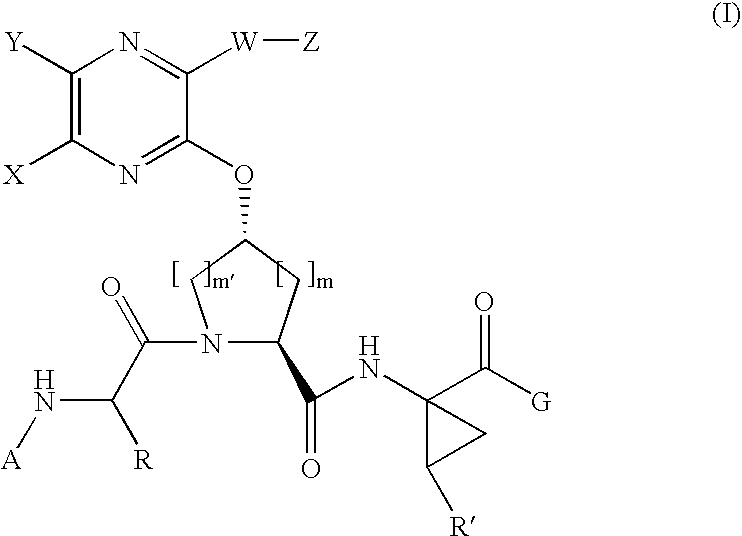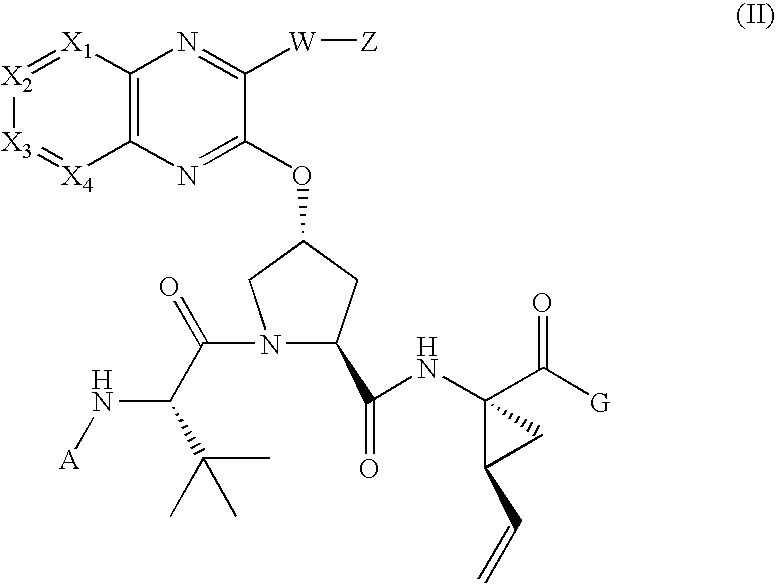Quinoxalinyl tripeptide hepatitis C virus inhibitors
a technology of hepatitis c virus and tripeptide, which is applied in the field of tripeptides, can solve the problems of interferon related side effects, inability to reproduce infectious culture systems and small-animal models for hcv, and increasing public health problems
- Summary
- Abstract
- Description
- Claims
- Application Information
AI Technical Summary
Problems solved by technology
Method used
Image
Examples
example 1
[0183]Compound of Formula IV, wherein
Step 1A
[0184]
[0185]To a solution of Boc-L-tert-leucine (4.544 g, 19.65 mmol), cis-L-hydroxyproline methyl ester (19.65 mmol) and DIPEA (10.3 ml, 59.1 mmol) in DMF (80 ml) at 0° C. was added in portions HATU (7.84 g, 20.6 mmol). The mixture was stirred at rt for 18 h, diluted with EtOAc and washed with half-sat.-aq. NaCl four times. The organic phase was dried over anhydrous MgSO4, filtered, and then concentrated in vacuo. The resudue was purified by silica gel chromatography (Hexane / EtOAC=1:1 to 1:2) to afford compound 1a (7.8 g). MS (ESI): m / e 359.24 (M+H).
Step 1B
[0186]
[0187]To a mixture of the above 1a (1.363 g, 3.803 mmol), 3-(thiophen-2-yl)-1H-quinoxalin-2-one (0.868 g, 3.803 mmol)) and triphenylphosphine (2.0 g, 7.6 mmol) in THF at 0° C. was added dropwise DIAD (1.5 ml, 7.6 mmol). The resulting mixture was held at 0° C. for 15 min. before being warmed to room temperature. After 18 hours, the mixture was concentrated under vacuum and the resi...
example 3
[0197]Compound of Formula IV, wherein A=H,
[0198]The title compound of Example 2 (25 mg, 0.0362 mmoL0 was treated with 4M HCl / dioxane (1 ml, 4 mmol). The mixture was stirred at room temperature for 1 hour, and concentrated in vacuo to dryness to affor the title compound (100%). MS (ESI): m / e 667.32 (M+H)
example 4
[0199]Compound of Formula IV, wherein
[0200]The title compound of Example 2 (0.0156 mmol) was dissolved in dichloromethane (1 m), cooled to 0° C., treated with DIPEA (27 ul, 10 eq.) followed by cyclopentylacetyl chloride (0.021 mmol). The mixture was stirred at room temperature for 0.5 to 1 hour, diluted with ethyl acetate, washed with half-sat.-aq. NaCl twice, dried (MgSO4) and concentrated in vacuo. The residue was purified by silica gel chromatography (Hexans / EtOAc=2:1 to 1:1) to give the title compound (8 mg). MS(ESI): m / e 779.42 (M+H).
PUM
| Property | Measurement | Unit |
|---|---|---|
| temperature | aaaaa | aaaaa |
| pH | aaaaa | aaaaa |
| width | aaaaa | aaaaa |
Abstract
Description
Claims
Application Information
 Login to View More
Login to View More - R&D
- Intellectual Property
- Life Sciences
- Materials
- Tech Scout
- Unparalleled Data Quality
- Higher Quality Content
- 60% Fewer Hallucinations
Browse by: Latest US Patents, China's latest patents, Technical Efficacy Thesaurus, Application Domain, Technology Topic, Popular Technical Reports.
© 2025 PatSnap. All rights reserved.Legal|Privacy policy|Modern Slavery Act Transparency Statement|Sitemap|About US| Contact US: help@patsnap.com



